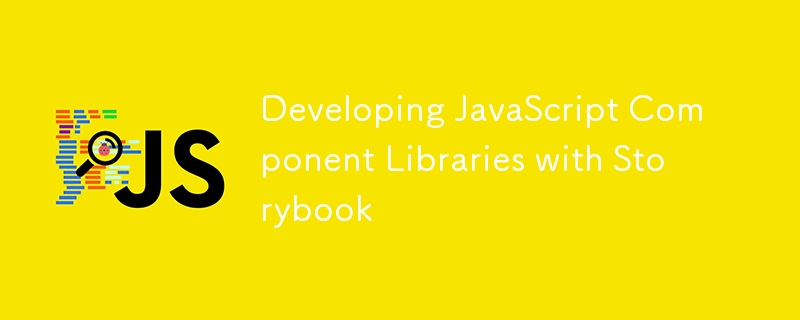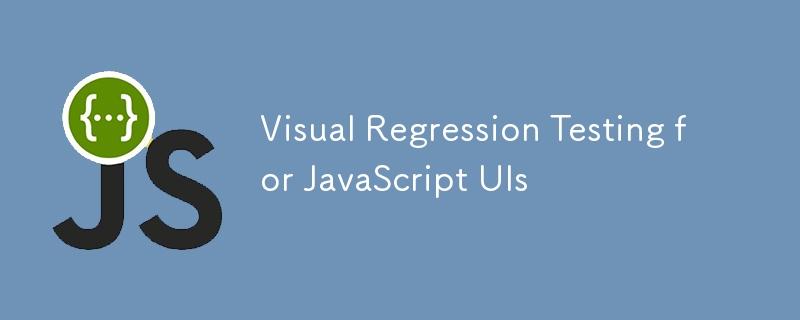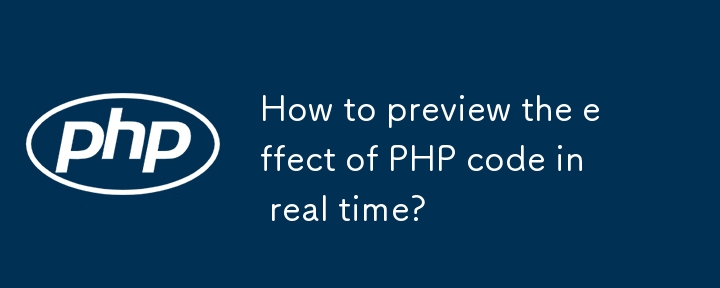Found a total of 10000 related content

Developing JavaScript Component Libraries with Storybook
Article Introduction:Using Storybook to develop JavaScript component libraries can improve debugging efficiency, support independent development and enhance documenting capabilities. 1. It is a framework-independent UI development tool that allows components to be developed and tested separately in an isolated environment; 2. Provide plug-in systems, such as Docs plug-in generating documents and Testing plug-in for interactive testing; 3. Initialize projects through npxsbinit, and automatically configure the dependencies and structure of the corresponding framework; 4. Each component should be stored and paired with .stories.js files, and use CSF format to define component status; 5. When packaging and publishing, use Rollup, Webpack or Vite tools, configure the entry file and generate the dist directory, and finally run n
2025-07-21
comment 0
963

How to set up static wordpress
Article Introduction:WordPress statically converts dynamic content into static HTML files to improve performance, security and SEO. The setup method is as follows: Use the WP Static HTML plug-in: Install and activate the plug-in, select "Generate static HTML file" and adjust the output options. Manual static: Create a new directory, copy all files except the core folder, create a .htaccess file and add the specified code.
2025-04-20
comment 0
683

Best VS Code extensions for Python
Article Introduction:Python developers should install the following plug-ins to improve efficiency when using VSCode: 1. The official Python plug-in provides functions such as smart prompts, code jumps, formatting, debugging, etc., and supports virtual environment switching; 2. Pylance, a language server built on Pyright, greatly improves the automatic completion speed and provides type check; 3. Jupyter plug-in, supports writing and running Notebook files in VSCode; 4. AutoDocstring, can automatically generate structured function comments. These plug-ins respectively optimize the core links in the development process, which can significantly improve development efficiency and code quality.
2025-07-01
comment 0
588

How do I define an Eloquent model? (php artisan make:model)
Article Introduction:The most direct way to define an Eloquent model in Laravel is to use the Artisan command phpartisanmake:model, which can quickly generate model classes and associate corresponding data tables. 1. Run phpartisanmake:modelPost to create a model file, which is saved in the app/Models directory by default (you need to confirm that the directory exists and the namespace is correct). 2. Use the -mf parameter to generate models, migrate files and model factories at the same time, making it easier to build a complete structure from scratch. 3. If the model path is customized to app/Models/Blog/Post.php, you can use phpartisanmake:model
2025-06-19
comment 0
944

How to disable directory listing in WordPress
Article Introduction:To disable the directory browsing function of WordPress site, 1. For the Apache server, add "Options-Indexes" to the .htaccess file to prohibit the display of directory contents; 2. For the Nginx server, modify the configuration file, set "autoindexoff" in the corresponding location block, and restart Nginx; 3. Upload the blank index.php or index.html file to the target directory to overwrite the directory list display; 4. Manually access specific directory paths to test whether the browsing function is enabled, or use the security plug-in to automatically detect and repair it. The above methods can effectively prevent the directory structure from being viewed externally and improve website security.
2025-07-31
comment 0
358

What is the autoload section in composer.json?
Article Introduction:Composer.json's autoload configuration is used to automatically load PHP classes, avoiding manual inclusion of files. Use the PSR-4 standard to map the namespace to a directory, such as "App\":"src/" means that the class under the App namespace is located in the src/ directory; classmap is used to scan specific directories to generate class maps, suitable for legacy code without namespace; files are used to load a specified file each time, suitable for function or constant definition files; after modifying the configuration, you need to run composerdump-autoload to generate an automatic loader, which can be used in the production environment --optimize or --classmap-
2025-06-12
comment 0
606

how to make a table of contents in word
Article Introduction:The key to automatically generating directories in Word is to use title styles. First, set the chapter title to "Title 1", "Title 2" and other styles to ensure clear levels; second, click "Reference" > "Table of Contents", select or customize the style and insert it; finally, right-click to select "Update Domain" when updating the directory, and select "Update the entire directory" or "Update only page number" as needed. In addition, pay attention to unifying the title format, adjusting the indentation alignment, and it is recommended to merge multiple chapter files and then generate the directory to avoid the hassle of later integration.
2025-07-29
comment 0
292

Best VS Code extensions for React
Article Introduction:Installing ES7 React/Redux/GraphQL/React-Nativesnippets can quickly generate React component templates, such as input rfc to generate function components, usestate inserts into useStateHook; 2. Use Prettier to automatically format the code when saving, and unify the team code style with .eslintrc files; 3. ESLint combined with plug-ins can check potential problems in React projects, such as missing or unused variables; 4. ReactDeveloperTools is a browser extension, used to debug component trees and locate source code. These plugins cover Reac
2025-06-30
comment 0
464

What is Autoprefixer and how does it work?
Article Introduction:Autoprefixer is a tool that automatically adds vendor prefixes to CSS attributes based on the target browser scope. 1. It solves the problem of manually maintaining prefixes with errors; 2. Work through the PostCSS plug-in form, parse CSS, analyze attributes that need to be prefixed, and generate code according to configuration; 3. The usage steps include installing plug-ins, setting browserslist, and enabling them in the build process; 4. Notes include not manually adding prefixes, keeping configuration updates, prefixes not all attributes, and it is recommended to use them with the preprocessor.
2025-07-02
comment 0
309

How do I create a new model in Yii?
Article Introduction:There are two main ways to create models in the Yii framework: 1. Use Gii to automatically generate models, and you can generate model classes and CRUD code by enabling Gii tools and accessing its interface to enter table names and class names; 2. Create a model file manually, create a new PHP file in models/ directory and define a class inherited from yii\db\ActiveRecord, and implement tableName(), rules(), attributeLabels() and other methods; in addition, you need to pay attention to the model naming specifications, automatic filling fields, model locations, and the difference between AR and non-AR models, and choose the appropriate method according to actual needs.
2025-07-14
comment 0
354

How to analyze Vue build bundle size?
Article Introduction:Key methods for analyzing the volume of packages after Vue build include: 1. Use VueCLI built-in analysis function to generate visual reports; 2. Install and configure the webpack-bundle-analyzer plug-in to view the module volume ratio; 3. Check the size of vendor.js and app.js files in the dist directory to judge the volume distribution; 4. Use npmmls, yarnlist or source-map-explorer to analyze the dependency tree and specific file contents to find out the redundant introduction and optimization space.
2025-07-17
comment 0
988

How to generate Javadoc?
Article Introduction:The key to generating Javadoc is to write good comments and master the basic commands and formats. 1. First, use the standard Javadoc comment block (starting with /* and ending with /) in the code, place it in front of the class, method, and field, and include summary sentences; 2. Use common tags such as @param, @return, @throws to describe parameters, return values ??and exceptions; 3. Use javadoc commands to generate documents through the command line. Common parameters include -d specifying the output directory, -author displaying the author, and -version displaying the version; 4. You can use the IDE to automatically generate documents, which is more convenient to operate. As long as you comment on specifications and be familiar with commands, you can easily generate clear API documents.
2025-07-02
comment 0
714

How do I configure files autoloading in my composer.json file?
Article Introduction:To use Composer to set up automatic loading of PHP projects, you must first edit the composer.json file and select the appropriate automatic loading method. If the most commonly used PSR-4 standard is adopted, the mapping of namespace and directory can be defined in the psr-4 field of autoload, such as mapping MyApp\ to src/directory, so that the MyApp\Controllers\HomeController class will automatically load from src/Controllers/HomeController.php; 1. After the configuration is completed, run composerdumpautoload to generate an automatic loading file; 2. If you need to be compatible with old code, you can use it.
2025-06-19
comment 0
741

How do I use the 'Go To Definition' feature in Sublime Text?
Article Introduction:SublimeText can implement the "jump to definition" function by installing the CTags plugin. First make sure that PackageControl is installed. If it is not installed, the installation will be completed through the official guide; then select "PackageControl:InstallPackage" through the command panel (Ctrl Shift P or Cmd Shift P) to search and install the CTags plug-in; then you need to install the ExuberantCtags or UniversalCtags tool, run ctags-R in the project root directory. Generate tags file; finally place the cursor on the target symbol and use the shortcut key Ctrl Shift Down
2025-06-18
comment 0
565

Java Code Quality and Static Analysis with SonarQube
Article Introduction:SonarQube is an open source code quality management platform used to detect code defects, security vulnerabilities, code odors, duplicate code in more than 20 languages such as Java, and evaluate test coverage and complexity. 1. Install the SonarQube server and access http://localhost:9000 to complete initialization; 2. Configure the SonarScanner tool or use the Maven/Gradle plug-in; 3. Create a sonar-project.properties file in the project root directory, specify the project information, source code path, compilation output and test report path; 4. Use Jacoco to generate a test coverage report and insert it through Maven.
2025-07-29
comment 0
208

Java Development with Visual Studio Code
Article Introduction:It is completely possible to use VisualStudioCode for Java development, especially suitable for small and medium-sized projects, learning or hybrid multilingual development. 1. Install the ExtensionPackforJava plug-in, which includes syntax support, debugging, testing, Maven and project management functions; 2. Configure the JDK environment, it is recommended to use OpenJDK11 or 17, and set JAVA_HOME. VSCode can automatically recognize or manually specify paths in the settings; 3. Create a project by using Maven through the command line or use the "Java:CreateaJavaproject" command in VSCode to quickly generate standard structures; 4. Enjoy intelligent completion and reconstruction when writing code.
2025-07-26
comment 0
977

How do you create a new Go module?
Article Introduction:To create a new Go module, first initialize the module with the gomodinit command, then write the code and add the dependencies, and finally run gomodtidy to organize the dependencies. 1. Run gomodinit (such as gomodinitgithub.com/yourusername/myproject) in the project directory to generate go.mod file; 2. Write code and import external packages. When running gobuild or gorun, Go will automatically download dependencies and update go.mod and go.sum; 3. Run gomodtidy to clean up unused dependencies and synchronize dependencies. After completing these steps, the module is correctly created and configured.
2025-08-02
comment 0
993

Visual Regression Testing for JavaScript UIs
Article Introduction:Visual Regression Testing is a test method that detects unexpected changes in UI through screenshot comparison. It works for page layout sensitive, component library, and multi-browser compatible projects, but not for dynamic content or prototype phase pages. Common tools include Percy, Cypress cypress-image-snapshot, and BackstopJS. The implementation steps are: install plug-ins, configure snapshots, generate benchmark diagrams, automatically compare and report error differences. Notes include a unified environment to avoid font rendering differences, dealing with animation influences, adjusting color accuracy thresholds, and regularly updating benchmark maps to adapt to UI evolution.
2025-07-17
comment 0
967

How do I automate Composer installations in a CI/CD pipeline?
Article Introduction:To automate Composer installation in CI/CD pipelines, the core is to run composerinstall at the right time and cooperate with the appropriate parameters. 1. Define the construction steps in CI configuration files such as .gitlab-ci.yml, use --no-dev to avoid installing the development package, and --prefer-dist prefers to use prepackaged versions to speed up downloads; 2. Use CI platform caching mechanisms such as GitHubActions' actions/cache@v2 plug-in to cache the vendor directory, and generate a cache key through composer.lock hash value to ensure that the new cache is triggered when dependencies are updated; 3. Safe installation of Composer requires verification of the installer checksum
2025-07-20
comment 0
1004

How to preview the effect of PHP code in real time?
Article Introduction:To achieve real-time preview of PHP code effects, you need to build a local development environment and use it with tools. 1. Use XAMPP, WAMP or MAMP to build a local server, place the PHP file in the specified directory and access it through localhost, and refresh the page after modification to view the results; 2. Use VSCode's LiveServer plug-in or PHPStorm to save and refresh the browser automatically; 3. Use var_dump() or print_r() to debug output variable information in combination with browser developer tools to assist in troubleshooting problems. Although these methods are not completely real-time, they can quickly feedback the results and improve development efficiency.
2025-06-28
comment 0
875



















